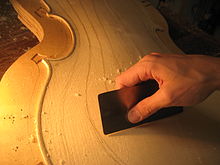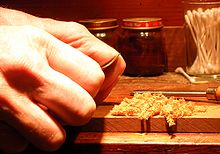Scraper
A scraper is a cutting tool used to smooth and clean surfaces made of wood , plastic or soft metal . The chips are removed by means of a fine, "painted" burr. This means that less material is removed than when planing with one cutting edge.
The scraper is made from a piece of thin tool steel and is 1 to 3 mm thick. They are available in a rectangular shape to work on flat surfaces, mostly around 150 mm × 70 mm in size, and with rounded blades in various radii for concave and convex workpieces. Scraper blades can be cut from the blade of worn saw blades.
application
The scraper can be pulled or pushed. In order to remove more material, the scraper is gripped with both hands. If it is moved away from the body, it is common to push it through a little with your thumbs. The resulting curvature reduces the chance that the corners of the blade will scratch the surface.
Among other things, scrapers were used by chair makers , in mold making and to rework the running surfaces of skis and snowboards .
Of parquet - and wood floor installers old coatings were removed with a scraper and refreshed the surface.
Scraper
With a scraper, a scraper is clamped to remove large areas and to remove glue traces and scraps of paper after veneering. Like the scraper, it has a short body with two side handles. The scraper is easy to change for sharpening.
Sharpen

By pulling the edge of the scraper at a right angle over the rounded edge of hardened steel, a fine, sharp burr forms on the scraper, which serves as a cutting edge to cut chips from the wood surface or remove coatings. The actual cutting edge is not, as usual, in the tool plane, but protrudes at a right angle from the edge of the scraper and is so fine that it is hardly visible. The position and sharpness of the burr can be determined by running your finger over it.
A simple tool for "re-sharpening" the blade is the scraper steel . Various devices are available to make resharpening easier, often referred to as gratz pullers .
A blunt scraper is a scraping tool , as the clearance angle and wedge angle combined are more than 90 degrees. With a blade with a sharp burr, this would only be the case if, as an exception, it was drawn very flat over the workpiece.
Scraper effect
The effect of a scraper is referred to as the “scraper effect”. For example, the effect of steel wool (in contrast to sandpaper, for example ) is based on the "scraper effect". During production, each fiber of the steel wool is given a sharp-edged ridge, which is pulled over the surface to be smoothed, cleaned or polished like a very fine scraper.
Various scrapers, some with a hole for mounting on a tool shaft with a handle, as well as a scraper steel .
The parquet squeegees (Les raboteurs de parquet) , painting by Gustave Caillebotte , 1875
Web links
- Instructions for sharpening scrapers
- Illustrated details in: Friedrich Kollenrott: Sharpening chisels, plane irons and scrapers - by hand Section 9 December 2013 - also as PDF
- detailed demonstration by Friedrich Kollenrott in: Andreas Duhme: "Workshop practice scrapers sharpening a tightrope walk to fine chips" HolzWerken 39, March / April 2013
Individual evidence
- ↑ a b c d Wolfgang Nutsch and others: Fachkunde für Schreiner (12th edition), Verlag Europa-Lehrmittel, Wuppertal 1980, pages 243–245, ISBN 3-8085-4011-7




